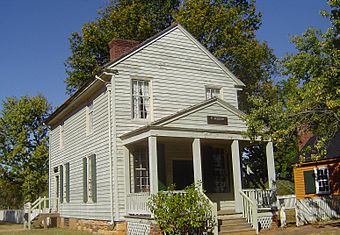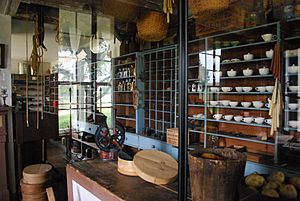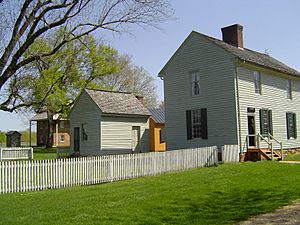Plunkett–Meeks Store facts for kids
Quick facts for kids |
|
|
Plunkett–Meeks Store
|
|
|
U.S. Historic district
Contributing property |
|

Plunkett–Meeks Store
|
|
| Lua error in Module:Location_map at line 420: attempt to index field 'wikibase' (a nil value). | |
| Location | Appomattox County, Virginia |
|---|---|
| Nearest city | Appomattox, Virginia |
| Built | 1852 |
| Architect | John H. Plunkett |
| Visitation | 185,443 (2009) |
| Part of | Appomattox Court House National Historical Park (ID66000827) |
| Added to NRHP | October 15, 1966 |
The Plunkett–Meeks Store is a structure within the Appomattox Court House National Historical Park. It was registered in the National Park Service's database of Official Structures on June 26, 1989.
History
The Plunkett–Meeks Store was built by John H. Plunkett in 1852 and later in the early 1860s purchased by Albert Francis Meeks, the village storekeeper, postmaster, and druggist. It was the social center of village life at what was then known as Clover Hill, Virginia. It is a major part of the historical setting of the Appomattox Court House National Historical Park. It represents the participation of the federal government in the preservation and commemoration of historically significant events.
Meek's son, known as Lafayette, died of typhoid fever while serving the Confederate army. He died when only nineteen years old and is buried behind the store. The store has been used from time to time as a private residence and at one time as the Presbyterian Church parsonage.
Historical significance
The building structure is important because it embodies the distinctive characteristics of a type, period, and method of construction in the mid-nineteenth century in rural Virginia. The buildings and resources of Plunkett–Meeks Store and storage building constitute a complete landscape typical of both a county government seat in Piedmont Virginia and of a farming community in the mid-nineteenth century in rural Virginia. It has historical meaning to the Appomattox Court House National Historical Park by virtue of its association with the site of General Robert E. Lee's surrender to General Ulysses S. Grant. The Plunkett–Meeks Store and storehouse building was registered and documented in the National Register of Historic Places on June 26, 1989.
Description
The Plunkett–Meeks Store is a two-story gray building with a basement and attic. It has a deep pointed rubble fieldstone raised foundation and sheathed in weatherboards with a gable wood shingle roof. The wood shingles are round-butt. The building is about twenty feet wide by thirty six feet deep. The north porch is five feet by sixteen feet. The east end of the Plunkett–Meeks Store has an eight-foot by eighteen-foot temple form entry porch on brick piers. The paried four-panel entry doors are flanked by 9/9 double hanging windows. The second floor has 6/9 double hanging windows.
The Plunkett–Meeks Store is enclosed at the second floor approached by a set of open riser stairs. The first floor is furnished and interpreted as a General Store and post office. The second floor is used for offices of the park. The structure was restored in 1959 and again in 1983. The structure was altered some in 1874.
Plunkett–Meeks storage building
The one story frame building was built by John Plunkett around 1850. The original orientation of the Plunkett–Meeks storage building is not known. It may have had doors facing the main village street and the Plunkett–Meeks Store and may have been located on the fence line at the southwest corner of the property.
The one story gray structure is sixteen feet wide by fourteen feet deep. It has a gable roof and deeply pointed, rough-cut, fieldstone piers. The structure is sheathed in weatherboards of about five and a half inches. They are covered by a clipped-corner wood shingle roof. The west and south entrances have four panel doors. The north side does not have any openings. The sash windows are 6/6 double hanging.
Its present location is next to the Plunkett–Meeks Store and behind the Woodson Law office, although this probably was not its original location when built originally by John Plunkett in 1850. The building was altered in 1874. It was restored by the National Park Service in 1959 and 1983.



